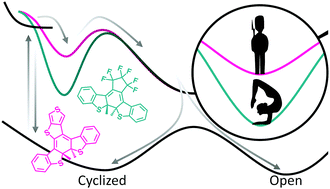Core structure dependence of cycloreversion dynamics in diarylethene analogs†
Abstract
Diarylperfluorocyclopentenes are a well-characterized class of molecular photoswitches that undergo reversible photocyclization. The efficiency of cycloreversion (<∼30%), in particular, is known to be limited by a competition with excited-state deactivation by internal conversion that is strongly impacted by the electron-withdrawing/donating character of pendant aryl groups. Here we present a first study to determine how varied structural motifs for the core bridge group impact excited-state dynamics that control cycloreversion quantum yields. Specifically, we compare photophysical behaviors of 3,3′-(perfluorocyclopent-1-ene-1,2-diyl)bis(2-methylbenzo[b]thiophene) with diarylethene derivatives possessing the same benzo[b]thiophene pendant group but with a rigid 1-methyl-1H-pyrrole-2,5-dione and a rigid/aromatic thieno[3,4-b]thiophene bridge (TT) core bridge group. We find that the flexible perfluorocyclopentene core undergoes cycloreversion 3–4× slower than the rigid core photoswitches (9 vs. 2–3 ps in acetonitrile, 25 vs. 5–6 ps in cyclohexane) despite comparable cycloreversion quantum yields. To distinguish effects induced by bridge vs. pendant groups, we also studied a series of photoswitches with the same thieno[3,4-b]thiophene bridging group, but with varied pendant groups including 2,5-dimethylthiophene and 2-(3,5-bis(trifluoromethyl)phenyl)-5-methylthiophene. Analysis of temperature-dependent excited-state lifetimes and cycloreversion quantum yields reveals that both the rates of nonreactive internal conversion and reactive cycloreversion increase with greater structural rigidity of the core. This difference is attributed to smaller energy barriers on the excited-state potential energy surface for both reactive and non-reactive deactivation from the 21A electronic state relative to the flexible perfluorocyclopentene switch, implying that a rigid core results in a net shallower excited-state potential energy surface.



 Please wait while we load your content...
Please wait while we load your content...